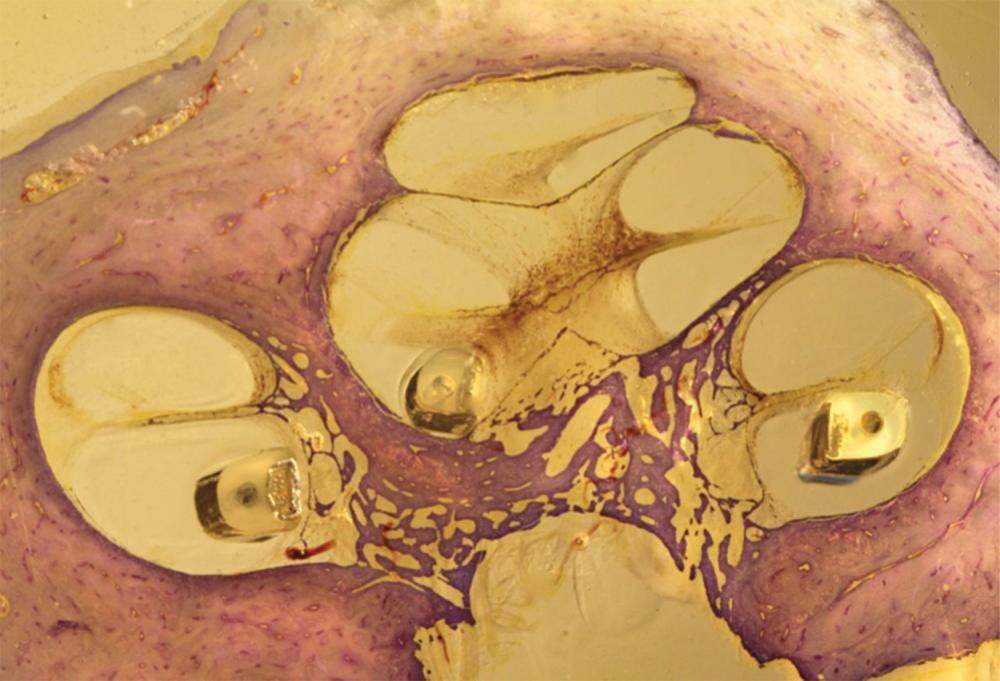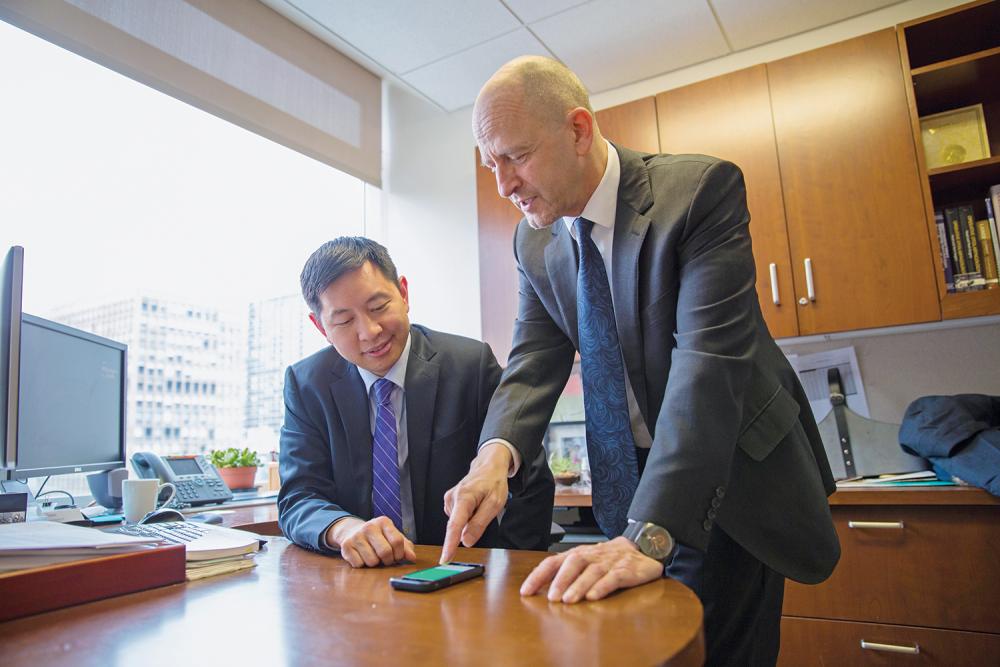
Susan B. Waltzman, PhD
Fueled by research, new developments in cochlear implant placement and programming are helping to improve the devices' effectiveness for patients who turn to them to restore their hearing.
Optimizing Cochlear Implant Placement
An innovative approach developed by NYU Langone Health researchers may optimize the length and placement of cochlear implant (CI) electrodes, improving patient outcomes while minimizing the risk of inner ear damage, which occurs when the electrodes are inserted too deeply.
"Our findings suggest that it's possible to stimulate lower-frequency auditory nerve fibers without deeper insertion of electrode arrays," says David M. Landsberger, PhD, assistant professor of otolaryngology—head and neck surgery and director of the Electric Auditory Research Laboratory at NYU Langone.
Although the appropriate placement of CI electrodes remains controversial, implantation typically involves placement in the first turn of the cochlea, where frequencies are encoded above approximately 1,000 Hertz. Extensive data suggest that stimulating the top of the cochlea can significantly improve outcomes for CI users, explains Dr. Landsberger.
A cadaver experiment led by Dr. Landsberger in collaboration with J. Thomas Roland Jr., MD, the Mendik Foundation Professor of Otolaryngology, chair of the Department of Otolaryngology—Head and Neck Surgery, and co-director of the Cochlear Implant Center, confirmed the research team's hypothesis: a return electrode inserted at the apex of the cochlea led to more even distribution of electrical current across high- and low-frequency areas.
"We were able to stimulate parts of the cochlea that are designed to encode for low frequencies, which in most implant systems are ignored," says Dr. Roland. Dr. Landsberger's team is now designing live human trials for the procedure.
Early Cochlear Implantation May Reduce Effects of Childhood Learning Disabilities
Early implantation of cochlear implants can help narrow the developmental gap between children born deaf and their normal-hearing peers, suggests new research led by Susan B. Waltzman, PhD, the Marica F. Vilcek Professor of Otolaryngology and co-director of the Cochlear Implant Center.
Although about half of children born deaf are eventually diagnosed with cognitive or learning disabilities that could impact CI performance, recent studies have shown that early implantation can help children adapt and acquire hearing on par with that of their peers. To measure the incidence of these conditions and their impact on patients' progress, Dr. Waltzman and her team followed almost 100 children who received implants when they were under 1 year of age, between 2000 and 2013.
Investigators found that about 10 percent of the children were later diagnosed with cognitive or learning issues, including attention deficit hyperactivity disorder (ADHD), Asperger's syndrome, and problems with executive functioning. Yet these children, who were diagnosed with additional issues at a mean age of seven, performed as well with their cochlear implants as those without disabilities.
"Our findings suggest that early implantation provides substantial developmental benefits, even in children who are diagnosed with other issues later on," says Dr. Waltzman. "It enables them to reach their potential by reducing the amount of 'catching up' they have to do later."
Despite the benefits of early implantation, Dr. Waltzman emphasizes the importance of setting realistic expectations for parents, since each child's performance can be affected by a host of developmental factors.
"Preoperative counseling for families is critical since we don't know what confounding issues might emerge as children get older," says Dr. Waltzman. "Ultimately, we have to wait and see."
Updated Algorithm and New App Offer Real-Time Noise Reduction
An updated algorithm created by researchers at NYU Langone and the NYU Tandon School of Engineering now offers noise-reduction benefits to CI users via smartphones.
The technology, dubbed Speech Enhancement using Decomposition Approach (SEDA) and first designed for desktop computers, addresses CI users' challenges with filtering out ambient noise in loud environments. SEDA2 builds on the original algorithm by enabling a smartphone's microphone to act as a preprocessor, filtering out background noise in real time before sound is sent to the CI processor. "SEDA2 can analyze very short audio frames, using a wavelet transform, in just milliseconds, creating a near-seamless experience for the CI user," explains Dr. Landsberger.
Once installed on a smartphone, the SEDA2 application analyzes and categorizes sound frames as dominated by noise or speech, then filters out background noise using an "adaptive group thresholding method" in a wavelet domain. In initial testing in CI users, the algorithm enabled significant improvements in speech quality and understanding.
The algorithm was developed by a team that included Dr. Landsberger, Ivan Selesnick, PhD, professor of electrical and computer engineering, and electrical engineering doctoral student Roozbeh Soleymani. Their research has been accepted for publication in the journal Speech Communication.
The researchers are now working on installing SEDA2 directly into the CI processor, to streamline its function and eliminate its reliance on an external device. In addition, investigators will continue to develop and refine the versatile algorithm to enable its potential use in a wide range of applications beyond CI enhancement—in any situation where hearing is impaired by ambient noise.
New Smartphone App Aids Cochlear Implant Fitting
A novel smartphone application developed at NYU Langone aims to streamline the complex cochlear implant programming process by rapidly exposing the device to frequency settings outside the audiology office.
"Patients can use the app to explore potential frequency allocation settings in real time and then bring that information to their audiologist," says Daniel Jethanamest, MD, clinical assistant professor of otolaryngology—head and neck surgery and director of the Division of Otology-Neurotology. "The audiologist can use the data as a starting point to program the device."
The app provides the first real-time method for electrical stimulation and adjustment of a patient's CI. Traditional CI fitting methods rely on a standard frequency allocation table (FAT) for all patients, regardless of differences in cochlea size or placement of electrodes, says the app's co-creator Mario A. Svirsky, PhD, the Noel L. Cohen Professor of Hearing Science and professor of neuroscience and physiology. However, patients often report distorted sound after implantation due to mismatches between the frequency function they experienced with normal hearing and that of the standard FAT.
"Most patients adapt to frequency mismatch over time, but some take quite a while and others never fully adjust," says Dr. Svirsky. "For those patients, an alternative FAT can enhance the quality of sound and, in some cases, improve speech perception."
In a small pilot study, all six subjects with CIs successfully used the app to experience different FATs while listening to running speech. Notably, all patients reported that an alternative to the standard FAT provided the best sound quality. Dr. Svirsky has filed a patent application for the frequency-to-electrode mapping technology underlying the app.
"Patients can use the app to explore potential frequency allocation settings in real time and then bring that information to their audiologist."—Daniel Jethanamest, MD



